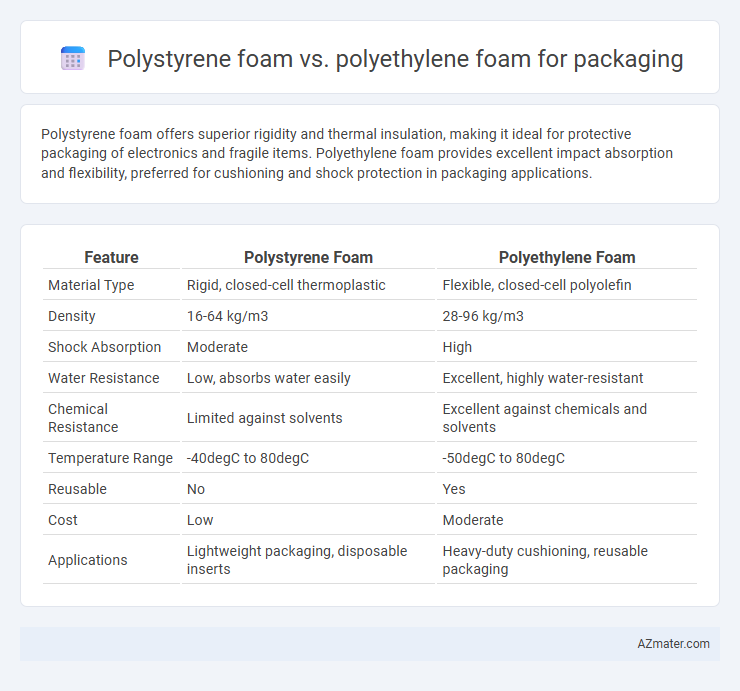Polystyrene foam offers superior rigidity and thermal insulation, making it ideal for protective packaging of electronics and fragile items. Polyethylene foam provides excellent impact absorption and flexibility, preferred for cushioning and shock protection in packaging applications.
Table of Comparison
| Feature | Polystyrene Foam | Polyethylene Foam |
|---|---|---|
| Material Type | Rigid, closed-cell thermoplastic | Flexible, closed-cell polyolefin |
| Density | 16-64 kg/m3 | 28-96 kg/m3 |
| Shock Absorption | Moderate | High |
| Water Resistance | Low, absorbs water easily | Excellent, highly water-resistant |
| Chemical Resistance | Limited against solvents | Excellent against chemicals and solvents |
| Temperature Range | -40degC to 80degC | -50degC to 80degC |
| Reusable | No | Yes |
| Cost | Low | Moderate |
| Applications | Lightweight packaging, disposable inserts | Heavy-duty cushioning, reusable packaging |
Introduction to Foam Packaging Materials
Polystyrene foam and polyethylene foam are widely used materials in packaging due to their cushioning and protective properties. Polystyrene foam offers excellent rigidity and impact resistance, making it ideal for fragile items, while polyethylene foam provides superior flexibility and water resistance, suitable for a variety of packaging applications. Both materials contribute to reducing damage during shipping by absorbing shocks and vibrations, ensuring product safety.
Overview of Polystyrene Foam
Polystyrene foam, commonly used in packaging, is a lightweight material known for its excellent insulation properties and shock absorption, making it ideal for protecting fragile items. Its rigid structure provides superior cushioning and impact resistance compared to polyethylene foam, which is softer and more flexible. Polystyrene foam is manufactured through the expansion of polystyrene beads, resulting in a closed-cell structure that offers moisture resistance and thermal insulation benefits.
Overview of Polyethylene Foam
Polyethylene foam is a versatile, closed-cell, resilient material commonly used in packaging for its excellent shock absorption, moisture resistance, and lightweight properties. Unlike polystyrene foam, polyethylene foam offers superior flexibility and durability, making it ideal for protecting delicate electronics and irregularly shaped items during shipping. Its chemical resistance and ability to be easily cut or shaped enhance its suitability for customized packaging solutions.
Physical and Mechanical Properties Comparison
Polystyrene foam offers high rigidity and excellent impact resistance, making it suitable for protecting fragile items, while polyethylene foam provides superior flexibility and cushioning due to its closed-cell structure. Polystyrene's higher compressive strength supports heavier loads but is more brittle compared to polyethylene, which excels in resilience and shock absorption under repeated stress. Density variations allow polystyrene to maintain shape under pressure, whereas polyethylene foam's elasticity enhances vibration dampening and compression recovery in packaging applications.
Cushioning Performance and Protection
Polystyrene foam offers excellent rigidity and high compressive strength, making it ideal for protecting fragile items during shipping by absorbing shocks and impacts. Polyethylene foam provides superior cushioning with better resilience and flexibility, which enhances vibration dampening and repeated impact resistance. Choosing between the two depends on the specific packaging needs; polystyrene foam is preferable for static protection, while polyethylene foam excels in dynamic cushioning performance.
Environmental Impact and Recyclability
Polystyrene foam, commonly used for packaging, is non-biodegradable and challenging to recycle, often ending up in landfills or oceans where it contributes to long-lasting environmental pollution. Polyethylene foam offers a more eco-friendly alternative due to its better recyclability and lower environmental footprint, as it can be repurposed into new foam products through mechanical recycling processes. However, the environmental impact of both materials depends on local recycling infrastructure, with polyethylene foam generally preferred for sustainable packaging solutions because of its higher recovery rates and reduced waste accumulation.
Cost Considerations
Polystyrene foam typically offers lower initial material costs compared to polyethylene foam, making it a cost-effective choice for large-scale packaging needs. However, polyethylene foam provides enhanced durability and reusability, potentially reducing long-term expenses despite its higher upfront price. Evaluating total cost of ownership, including material, transportation, and waste management expenses, is crucial for choosing between these foams in packaging applications.
Applications in Packaging Industries
Polystyrene foam excels in packaging applications requiring rigid, impact-resistant protection, making it ideal for fragile electronics and appliances due to its lightweight and cushioning properties. Polyethylene foam offers superior flexibility and resilience, commonly used in packaging delicate items like glassware and food products where moisture resistance and shock absorption are critical. Packaging industries favor polyethylene foam for eco-friendly solutions and reusable packaging, while polystyrene foam remains popular for cost-effective, disposable packaging materials.
Customization and Design Flexibility
Polystyrene foam offers limited customization options due to its rigid structure, making it ideal for packaging that requires firm protection but less intricate shapes. Polyethylene foam provides superior design flexibility with its soft, pliable nature, allowing for custom shapes, varying densities, and easy contouring to protect fragile items. This versatility makes polyethylene foam the preferred choice for packaging solutions requiring tailored cushioning and adaptable design features.
Choosing the Right Foam for Your Packaging Needs
Polystyrene foam offers excellent rigidity and superior cushioning for fragile items, making it ideal for electronics and delicate goods, while polyethylene foam provides greater flexibility, moisture resistance, and impact absorption suitable for heavier, irregular-shaped products. When choosing the right foam for your packaging needs, consider factors such as weight capacity, environmental exposure, and product fragility to ensure optimal protection and cost efficiency. Both materials can be customized in density and thickness, enabling tailored solutions for diverse shipping and storage requirements.

Infographic: Polystyrene foam vs Polyethylene foam for Packaging
 azmater.com
azmater.com